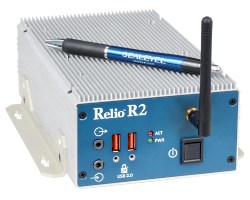Is Gigabyte-Capable WiFi Coming Soon to a Factory Near You?
 WiFi continues to advance with the arrival of 802.11ac, the latest update to the standard designed to give mobile device users faster data throughput speeds. The update could more than double network data throughput speeds. The downside? A tradeoff in how far signals carry and the number of channels available for use.
WiFi continues to advance with the arrival of 802.11ac, the latest update to the standard designed to give mobile device users faster data throughput speeds. The update could more than double network data throughput speeds. The downside? A tradeoff in how far signals carry and the number of channels available for use.
These tradeoffs suggest that, though 802.11ac access points are likely to become increasingly available in 2014, this may not be the year the technology becomes the standard in business communications. More likely, it will take off in settings where the highest available data throughput speeds are a requirement and a WLAN is being built for the first time. In other words, early adopters are likely to be consumers who are looking to dedicate a WLAN and can afford to upgrade client hardware as it becomes available.
This emerging technology standard is one of two (the other being 802.11ad, also known as WiGig) coming out of the wireless industry that have the potential to change processes for data acquisition in factory environments.
Industrial applications demand fast throughput
Let’s consider how industrial data acquisition works. Sensors measure something — it could be an electrical signal, a change in temperature or pressure, or a vibration. Acquired data is captured and transformed by hardware with instrumentation appropriate to its application, which then transmits it across a network to monitoring software.
Speed of data transmission for such data acquisition remains a high priority in manufacturing environments. In many automated settings, process engineers and network architects have had to plan and test carefully when including local WiFi networks in collections. Often the past result has been that the physical plant design must use wired connections to handle this process in order to meet real-time monitoring requirements.
Finally having faster data throughput capabilities over wireless access points is enticing because it mitigates the risk that critical data transmissions will be cut off if something goes wrong: Radio signals cannot be cut or damaged by heat the way factory floor or ceiling wire runs can be. Even though some of the same limitations that have always applied with radio transmissions — such as needing line-of-sight — still apply, technical publications continue to discuss the potential impact of wireless data acquisition in the development of the “smart factory.”
Benefits of wireless data acquisition
Wireless industry experts and executives have been telling us about the potential benefits of acquiring data over WiFi for years:
- In this interview, an executive describes a nuclear power plant using a wireless remote monitoring application to gather data and set maintenance schedules.
- This article, now two years old, describes a detailed testing methodology for verifying 802.11ac can meet WLAN requirements in a manufacturing environment.
- This “think piece” about Industry 4.0 considers the risks and benefits of using 802.11ac and 802.11ad equipment in a futuristic smart factory.
Overcoming obstacles
Security will be a serious design concern for any organization looking at deploying either of the new standards emerging from the wireless industry. Such risks have drawn the attention of the National Institute of Standards and Technology, part of the U.S. Department of Commerce, an agency that kicked off a project last year to develop guidelines for implementing secure real-time wireless platforms for manufacturing environments.
Though 2014 probably won’t be the year of fully automated smart factory deployments, we expect to learn of more efforts testing 802.11ac and 802.11ad equipment in pilot projects. We will continue to hear from standards bodies and wireless industry think tanks about the viability of using these technologies on factory floors.
Has your business begun testing WLAN equipment? What network use cases are you exploring? An audit of your production processes to discover and mitigate potential obstacles to wireless data transmission may be a good first step.
Categories:
